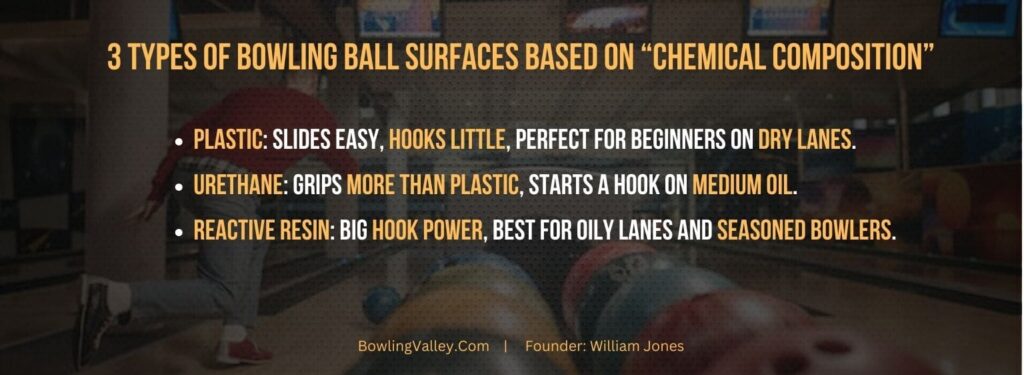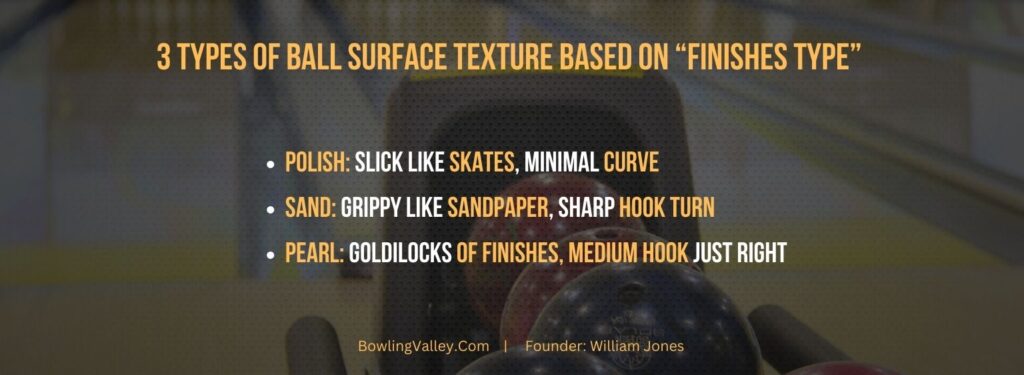Well, it’s time to explore the different types of bowling ball surfaces and how they can impact your performance on the lanes.
Today we will define different surfaces based on “chemical composition” and “finishes type”.
In chemical composition, we will look into plastic, urethane, and reactive bowling ball surface type.
Likewise, in bowling ball surface finishes there comes 3 categories – polish, sand, or pearl surface.
The surface of your ball plays a crucial role in its movement and hook potential.
So In this article, we’ll guide you through the complete process of choosing the right surface and surface finish type for yourself.
PS: If you are time-pressed, only going through the tables ahead would be a smart move! ;D
Jump to a Specific Section
- 1 3 Types of Bowling Ball Surfaces Based on Chemical Composition
- 2 3 Types of Bowling Ball Surface Finishes
- 3 How to Choose the Right Bowling Ball Surface for Yourself? – Concise Table
- 4 Frequently Asked Questions
- 4.1 What Factors Should I Consider When Choosing a Bowling Ball Surface?
- 4.2 Can I Change the Surface Texture of My Bowling Ball?
- 4.3 Are There Any Specific Cleaning Techniques for Maintaining the Surface of a Bowling Ball?
- 4.4 How Often Should I Resurface My Bowling Ball?
- 4.5 What Are the Benefits of Using a Polished Bowling Ball Surface
- 5 Closing Words – “Types of Bowling Ball Surfaces”
3 Types of Bowling Ball Surfaces Based on Chemical Composition

Let’s talk about the different types of bowling ball surfaces.
| Surface Type | Skill Level | Description | Benefits | Drawbacks |
|---|---|---|---|---|
| Plastic | Beginners | Smooth surface, minimal hook | Easy to control, perfect for learning form | Less curve potential, not ideal for oily lanes |
| Urethane | Intermediate bowlers | More grip than plastic, developing hook | Improved control, better ball performance on medium oil lanes | Requires regular maintenance, experiment with grit levels |
| Reactive Resin | Advanced bowlers | Aggressive hook potential, ideal for oily lanes | Strong reaction, heavy curve potential | Not recommended for dry lanes, advanced skill required |
1. Plastic: Smooth Surface for Minimal Hook, Good for Beginners and Dry Lanes
For beginners and those bowling on dry lanes, a plastic ball with a smooth surface is the way to go.
This type of ball will glide smoothly down the lane with minimal hook, making it easier to control and perfect for those just starting out.
Think of it as a trusty friend you can rely on for consistent throws.
Its predictable, controlled movement lets you focus on perfecting your form without worrying about unpredictable curves.
2. Urethane: More Grip than Plastic, Good for Medium Oil Conditions and Developing Hook
When transitioning from a plastic bowling ball, you’ll find that urethane offers more grip and is well-suited for medium oil conditions and developing hook.
Urethane balls have a higher friction level, allowing you to have better control over the ball’s movement on the lane.
This increased grip translates to improved ball performance, as you’ll be able to generate more hook potential.
Urethane balls are particularly effective on medium oil lane conditions, where their ability to dig into the oil and create friction helps maintain a consistent hook.
It’s important to note that urethane balls require regular ball maintenance to maintain their performance.
Choosing the right surface for your urethane ball will depend on the specific lane conditions you encounter, so make sure to experiment with different grit levels to find the optimal surface for your game.
3. Reactive Resin: Most aggressive Hook Potential, Ideal for Oily Lanes and Advanced Bowlers
To maximize your performance on oily lanes and take advantage of the most aggressive hook potential, reactive resin bowling balls are the ideal choice for advanced bowlers.
Reactive resin balls are designed to create a strong reaction on the lane, allowing you to achieve a powerful hook.
These balls are made with a special additive that enhances their ability to grip the lane surface, even in heavy oil conditions.
The aggressive hook potential of reactive resin balls means that they’re able to create a significant amount of angular motion, making them perfect for advanced bowlers who want to curve the ball sharply.
If you’re an advanced bowler looking to dominate on oily lanes, a reactive resin ball with its aggressive hook is your ticket to success.
3 Types of Bowling Ball Surface Finishes

Within each material, different surface finishes add another layer of personality.
| Surface Finish | Ideal For | Description | Benefits | Drawbacks |
|---|---|---|---|---|
| Polished | Drier lanes | Smooth surface, minimal hook | Easy control, less friction, predictable path | Less curve potential, not ideal for oily conditions |
| Sanded | Oily lanes | Rough texture, increased hook | Strong grip, sharper curve, heavy oil control | Less skid, advanced skill required, more maintenance |
| Pearl | Medium to heavy oil | Balanced texture, moderate hook | Versatile performance, adapts to different conditions | Less aggressive than sanded, not ideal for dry lanes |
1. Polished: Slides More, Less Hook for Drier Lanes
For drier lanes, polish your bowling ball to create a surface that allows it to slide more and have less hook.
The dull finish of a ball is better suited for oily lane conditions, where it can create friction and generate more hook.
However, on drier lanes, a polished surface is ideal as it reduces friction and allows the ball to glide smoothly. The reduced hook potential of a polished ball means less hook motion, giving you more control over your shots.
It’s important to note that regular surface maintenance is necessary to maintain the polished finish.
2. Sanded: Grips the Lane More, Creates More Hook for Oily Lanes
Increasing the surface texture of your bowling ball by sanding it will enhance its ability to grip the lane, creating more hook on oily lanes.
Sanded surfaces are ideal for bowlers who want to maximize their control and performance on lanes with heavy oil patterns.
The rough surface texture of a sanded bowling ball provides increased friction with the lane, allowing it to grip the surface more effectively.
This increased grip translates into a greater hook potential, as the ball can dig into the oil and create a sharper angle towards the pocket.
3. Pearl: In-between Polish and Sanded, Offering a Balance of Hook and Skid
One option for enhancing the surface texture and hook potential of your bowling ball is the pearl finish, which offers a balance of hook and skid.
The pearl ball provides a unique combination of surface friction and ball motion, allowing you to have more control over your shots.
Compared to polished balls, the pearl finish provides slightly more traction, giving you increased hook potential on medium to heavy oil lane conditions.
On the other hand, when compared to sanded balls, the pearl finish offers more skid, allowing the ball to glide smoothly down the lane before making its move towards the pocket.
This versatility makes the pearl ball suitable for a wide range of lane conditions, providing you with the freedom to adapt your game to different oil patterns and achieve optimal performance.
How to Choose the Right Bowling Ball Surface for Yourself? – Concise Table
To understand how the surface impacts ball movement and to choose the right bowling ball surface for yourself, you need to consider various factors.
Factors like lane conditions, oil patterns, and your individual bowling style should be considered when choosing the right ball surface.
| Lane Condition | Skill Level | Material/Finish Combo | Benefits | Drawbacks |
|---|---|---|---|---|
| Dry | Beginner | Plastic/Polished: EASIEST control, predictable | Budget-friendly, NO strong hook | |
| Dry | Intermediate | Urethane/Pearl: Moderate control, developing HOOK | Smoother glide, some hook variation | Less hook than sanded, less aggressive than reactive |
| Dry | Intermediate | Urethane/Polished: Control with slightly MORE hook than plastic | Good transition ball, less maintenance than sanded | (Optional: Not as versatile as pearl) |
| Medium | Beginner | Urethane/Pearl: Balanced control and hook | Adaptable, good for learning | May not dominate in either aspect |
| Medium | Intermediate | Urethane/Sanded: Strong grip, controlled hook, good oil penetration | Versatility, good oil response | Requires skill to manage, higher maintenance |
| Medium | Advanced | Reactive Resin/Pearl: Versatile hook potential, good oil response | Strong hook without being overly aggressive | More expensive than plastic or urethane, some maintenance needed |
| Oily | Intermediate | Reactive Resin/Pearl: Versatile hook potential, strong oil response | Powerful hook without losing control | More expensive than urethane, some maintenance needed |
| Oily | Advanced | Reactive Resin/Sanded: Maximum hook potential, aggressive lane interaction | Dominates oily lanes, precise curve control | Very difficult to control, high maintenance, not for dry lanes |
Notes:
- Plastic only has polished finish due to its limited hook potential on dry lanes.
- Urethane/Polished is included as an optional choice for intermediate bowlers on slightly dry lanes who prefer a touch more hook than plastic.
- Both pearl and sanded are common for reactive resin on oily lanes, catering to different levels of desired hook and skill.
Disclaimer: This table is a general guide. Experimentation and consulting a pro are encouraged to find your perfect match.
Frequently Asked Questions
What Factors Should I Consider When Choosing a Bowling Ball Surface?
When choosing a bowling ball surface, consider factors such as weight selection, core types, coverstock materials, hook potential, and drilling layouts. These choices will give you the freedom to achieve your desired results on the lanes.
Can I Change the Surface Texture of My Bowling Ball?
Yes, you can change the surface texture of your bowling ball to enhance performance. Different finishes can be applied based on professional recommendations. However, be aware of the long-term effects on the ball’s lifespan.
Are There Any Specific Cleaning Techniques for Maintaining the Surface of a Bowling Ball?
To maintain the surface of your bowling ball, there are specific cleaning techniques you can use. Regularly wipe the ball with a microfiber cloth and use a specially formulated cleaner. This will help keep the surface in the best condition for optimal performance.
How Often Should I Resurface My Bowling Ball?
You should resurface your bowling ball as needed depending on the signs of a worn out surface. If you’re up for it, you can try DIY resurfacing, but keep in mind that lane conditions can also impact the ball surface. Professional resurfacing services are available too.
What Are the Benefits of Using a Polished Bowling Ball Surface
Using a polished bowling ball surface offers you performance advantages. It increases hook potential, improves control, enhances pin carry, and reduces friction. Imagine the freedom you’ll feel with these benefits!
Closing Words – “Types of Bowling Ball Surfaces”
So, when it comes to choosing the right bowling ball surface for yourself, it’s important to consider the various types and their impact on ball movement.
Just like a master painter carefully selects their brushes, you too should select the surface that will give you the desired hook and control.
Remember, the right surface can make all the difference in your bowling game, so choose wisely and let your skills shine on the lanes.
